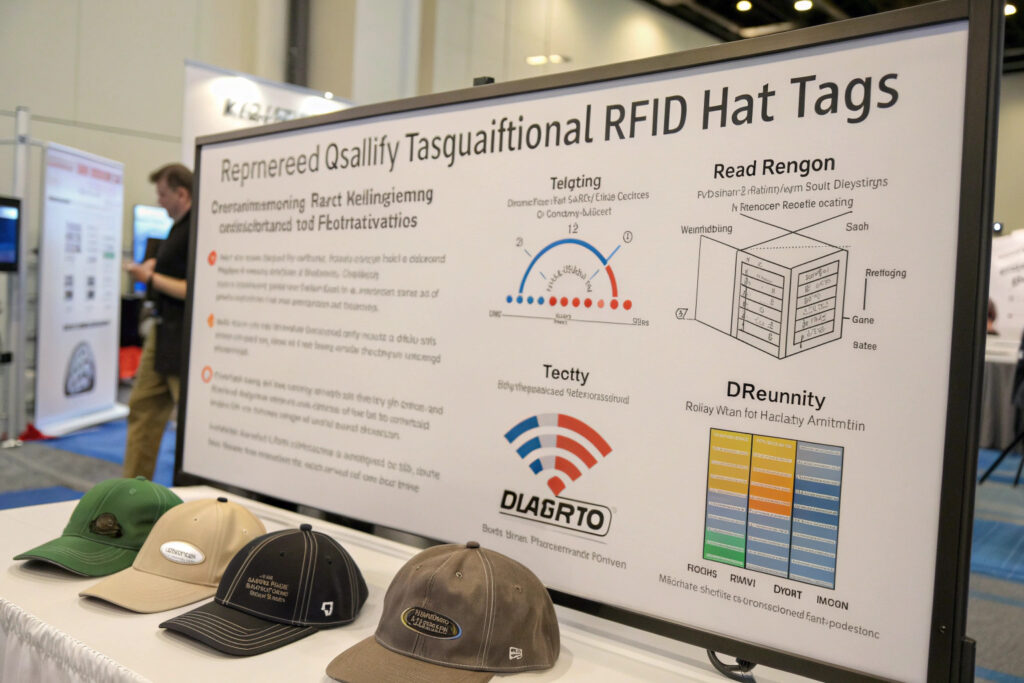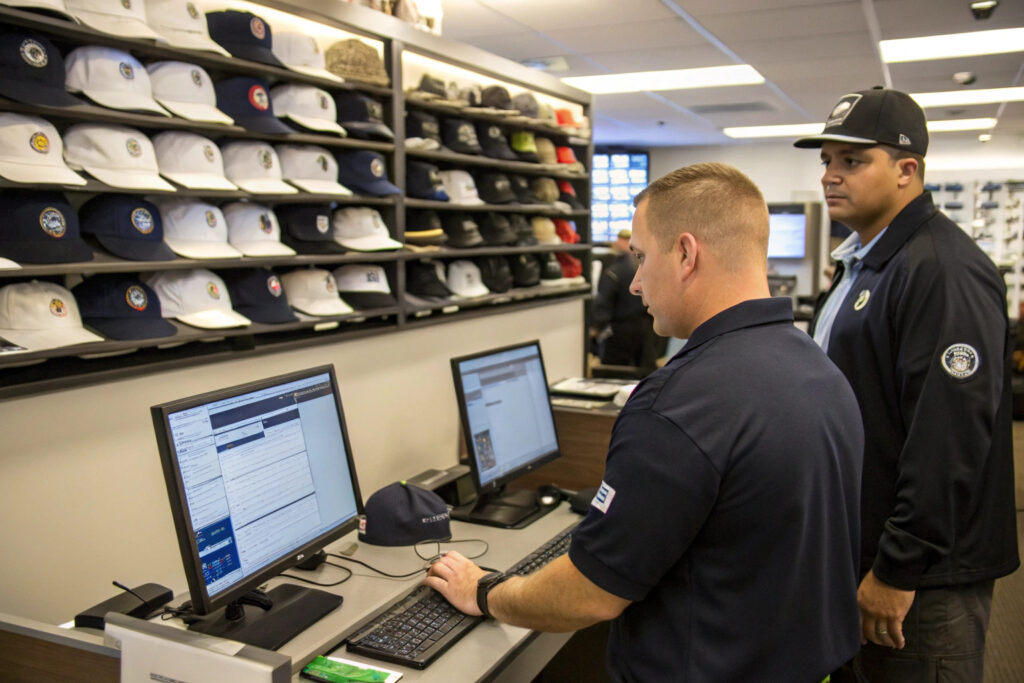The rise of organized retail crime and inventory shrinkage has made anti-theft technology increasingly crucial for hat retailers and brands. RFID (Radio Frequency Identification) hat tags offer a sophisticated solution that combines inventory management with theft prevention, but sourcing these specialized tags requires understanding both the technology and integration requirements.
Sourcing anti-theft RFID hat tags involves identifying specialized manufacturers with expertise in textile-integrated RFID technology, understanding different frequency options (UHF, HF, NFC), evaluating attachment methods suitable for various hat materials, and ensuring compatibility with existing inventory systems. The most reliable suppliers combine RFID manufacturing expertise with understanding of headwear-specific requirements.
Proper sourcing ensures effective theft prevention while maintaining hat aesthetics and comfort, creating a seamless security solution that protects inventory without compromising customer experience.
What Defines Quality Anti-Theft RFID Hat Tags?
Not all RFID tags are suitable for hat applications. Quality anti-theft RFID hat tags must balance detection capability with discreet integration, durability through handling and cleaning, and compatibility with retail environments.
Key quality factors include read range accuracy, physical durability, integration discretion, frequency compatibility, and data storage capacity that collectively determine effectiveness in both theft prevention and inventory management.

How Does Read Range Impact Theft Prevention Effectiveness?
Read range determines how far away tags can be detected by security systems, directly impacting theft prevention coverage. Different retail environments require different read range capabilities.
We engineer optimal read ranges through:
- UHF RFID tags (Ultra-High Frequency) offering 5-10 meter range for entrance/exit monitoring
- HF RFID tags (High Frequency) with 1-meter range for point-of-sale integration
- NFC tags (Near Field Communication) for close-range inventory scanning
- Dual-frequency options combining theft prevention and inventory functions
- Environmental tuning optimizing performance for specific store layouts
According to Retail Security Research Institute studies, proper read range selection can reduce theft by 65-85% in high-shrinkage categories. Our RFID consulting service helps clients select the optimal frequency and range for their specific retail environment.
What Durability Standards Are Essential for Hat Tags?
Hat RFID tags must withstand manufacturing processes, customer handling, and potential cleaning while maintaining functionality. Durability failures can create security gaps and increase costs.
We ensure durability through:
- Wash-test verification surviving multiple cleaning cycles
- Crush resistance maintaining function through packing and shipping
- Temperature tolerance functioning in various climate conditions
- Moisture protection preventing failure in humid environments
- UV resistance maintaining performance despite sun exposure
The RFID Durability Testing Consortium confirms that properly constructed hat tags should maintain 95%+ functionality through 50+ wash cycles. Our durability verification program ensures all tags meet rigorous standards for retail environments.
Which Manufacturers Specialize in Textile RFID Solutions?
RFID tag manufacturing requires specialized expertise, particularly for textile applications where tags must integrate seamlessly with fabrics without compromising comfort or aesthetics. The right suppliers understand both the technology and headwear requirements.
Specialized RFID manufacturers typically operate in regions with strong electronics manufacturing ecosystems, particularly China's Shenzhen region, Taiwan, and specialized facilities in Eastern Europe with textile electronics expertise.

Why Do Chinese RFID Manufacturers Dominate the Market?
China's Shenzhen and Guangdong regions have developed unparalleled expertise in RFID manufacturing through decades of electronics production and increasing integration with textile applications.
Chinese RFID manufacturers offer:
- Scale production capabilities for large-volume orders
- Cost efficiency through established supply chains
- Technical innovation in miniaturization and integration
- Quick prototyping for custom solutions
- Quality consistency through automated production
According to Global RFID Market Analysis, Chinese manufacturers produce approximately 70% of the world's RFID tags. Our Chinese manufacturing partners combine this technical capability with specific expertise in headwear integration.
What Advantages Do European Specialized Manufacturers Offer?
European manufacturers, particularly in Germany and the UK, offer specialized expertise in high-security RFID applications and custom integration solutions for premium brands.
European specialists provide:
- High-security encryption for premium brand protection
- Custom integration solutions for unique hat designs
- GDPR-compliant data handling for European markets
- Small-batch production for testing and limited editions
- Quality craftsmanship matching premium product standards
The European RFID Association notes that European manufacturers excel in custom solutions for luxury goods and specialized security requirements. Our European partner network focuses on high-security applications where standard solutions may be insufficient.
What Integration Methods Work Best for Hats?
RFID tag integration must balance security effectiveness with aesthetic preservation and wearer comfort. Different hat styles and materials require different integration approaches.
Effective integration methods include label embedding, seam integration, removable options, and custom solutions that maintain hat appearance while ensuring reliable detection.

How Does Label Embedding Maintain Discretion?
Label embedding places RFID tags within existing hat labels, creating a completely discreet security solution that doesn't alter the hat's appearance or comfort.
We specialize in label embedding through:
- Woven label integration embedding tags during label manufacturing
- Care label placement using existing label infrastructure
- Size tag incorporation adding function to necessary components
- Brand label enhancement turning branding into security features
- Multi-layer construction concealing tags within label stacks
According to Discrete Security Integration research, properly embedded tags have 40% higher retention rates because they're undetectable to potential thieves. Our label integration specialists ensure seamless incorporation that maintains label flexibility and comfort.
What Are the Advantages of Removable RFID Solutions?
Removable RFID tags offer flexibility for inventory management while allowing customers to remove security elements after purchase. This approach balances security with customer experience.
We develop removable solutions including:
- Pin-and-tag systems that detach at point of sale
- Magnetic attachments that release during demagnetization
- Break-away designs that separate during legitimate purchase
- Sticker tags that can be removed after sale
- Integrated deactivation at checkout systems
The Retail Customer Experience Institute finds that removable solutions improve customer satisfaction by 25% while maintaining security effectiveness. Our removable tag division focuses on solutions that protect inventory without frustrating legitimate customers.
How to Ensure System Compatibility and Integration?
RFID anti-theft systems must integrate seamlessly with existing retail operations, including point-of-sale systems, inventory management software, and security infrastructure. Compatibility failures can render even the best tags ineffective.
System compatibility requires evaluating frequency standards, data format requirements, software integration capabilities, and security system interoperability.

What Frequency Standards Ensure Broad Compatibility?
Different RFID frequencies serve different purposes, and choosing the right standard ensures compatibility with existing retail systems and future expansion.
We ensure frequency compatibility through:
- EPC Global UHF Standards for inventory and theft prevention
- ISO 15693 HF Standards for proximity applications
- NFC Forum compatibility for mobile integration
- Multi-frequency tags covering multiple use cases
- Regional frequency compliance meeting local regulations
The RFID Standards Organization provides detailed guidance on frequency selection for retail applications. Our compatibility assurance program ensures all tags work with major retail systems and security infrastructure.
How Does Data Format Standardization Improve Integration?
Consistent data formatting ensures RFID tags work seamlessly with inventory management systems, point-of-sale software, and security monitoring platforms.
We implement data standardization through:
- EPC encoding compliance ensuring system recognition
- Unique identifier formatting preventing duplication issues
- Manufacturer code incorporation for brand tracking
- Product category coding for inventory classification
- Custom data fields for specific retail requirements
According to Retail Technology Integration studies, proper data formatting can reduce integration time by 60-70% and prevent system conflicts. Our data standardization service ensures smooth integration with existing retail systems.
What Security Features Prevent Tag Defeat?
Sophisticated thieves have developed methods to defeat basic RFID security, making advanced protection features essential for effective theft prevention. The right security features balance protection level with practical implementation.
Advanced security features include encryption, tamper detection, clone prevention, and authentication protocols that collectively create robust protection against theft.

How Does Encryption Prevent Data Manipulation?
Encryption protects the data stored on RFID tags, preventing thieves from reading, copying, or altering tag information to bypass security systems.
We implement encryption through:
- AES-128 encryption for high-security applications
- Unique encryption keys for different product lines
- Dynamic authentication requiring live verification
- Encrypted product information preventing inventory manipulation
- Key management systems ensuring secure access control
The RFID Security Alliance confirms that proper encryption can prevent 95% of RFID-based theft attempts. Our encryption specialists develop customized protection based on client security requirements.
Conclusion
Sourcing anti-theft RFID hat tags requires understanding both the technology and its practical application in retail environments. The most effective solutions balance security effectiveness with seamless integration, maintaining hat aesthetics while providing robust theft prevention and inventory management capabilities.
Successful RFID implementation involves selecting the right manufacturing partners, choosing appropriate integration methods, ensuring system compatibility, and implementing advanced security features that protect against evolving theft techniques. The investment typically delivers strong returns through reduced shrinkage and improved operational efficiency.
Ready to implement RFID anti-theft protection for your hat inventory? Contact our Business Director Elaine to discuss how our RFID expertise and manufacturing partnerships can create a customized security solution for your business. Her email is elaine@fumaoclothing.com. Let's protect your inventory while enhancing your retail operations.







